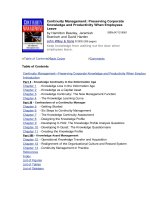John wiley sons audel automated machines and toolmaking (2004) 5ed yyepg lotb
Bạn đang xem bản rút gọn của tài liệu. Xem và tải ngay bản đầy đủ của tài liệu tại đây (23.06 MB, 503 trang )
TeAM
YYeP
G
Digitally signed by
TeAM YYePG
DN: cn=TeAM YYePG,
c=US, o=TeAM YYePG,
ou=TeAM YYePG,
email=
Reason: I attest to the
accuracy and integrity
of this document
Date: 2005.04.26
21:48:59 +08'00'
Audel
™
Automated Machines
and Toolmaking
All New 5th Edition
Audel
™
Automated Machines
and Toolmaking
All New 5th Edition
Rex Miller
Mark Richard Miller
Vice President and Executive Group Publisher: Richard Swadley
Vice President and Executive Publisher: Robert Ipsen
Vice President and Publisher: Joseph B. Wikert
Executive Editorial Director: Mary Bednarek
Editorial Manager: Kathryn A. Malm
Executive Editor: Carol A. Long
Senior Production Manager: Fred Bernardi
Development Editor: Kevin Shafer
Production Editor: Vincent Kunkemueller
Text Design & Composition: TechBooks
Copyright © 2004 by Wiley Publishing, Inc. All rights reserved.
Copyright © 1965, 1970, and 1978 by Howard W. Sams & Co., Inc.
Copyright © 1983 by The Bobbs-Merrill Co., Inc.
Copyright © 1986 by Macmillan Publishing Company, a division of Macmillan Inc.
Published simultaneously in Canada
No part of this publication may be reproduced, stored in a retrieval system, or transmitted
in any form or by any means, electronic, mechanical, photocopying, recording, scanning,
or otherwise, except as permitted under Section 107 or 108 of the 1976 United States
Copyright Act, without either the prior written permission of the Publisher, or authorization through payment of the appropriate per-copy fee to the Copyright Clearance Center,
Inc., 222 Rosewood Drive, Danvers, MA 01923, (978) 750-8400, fax (978) 646-8600.
Requests to the Publisher for permission should be addressed to the Legal Department,
Wiley Publishing, Inc., 10475 Crosspoint Blvd., Indianapolis, IN 46256, (317) 572-3447,
fax (317) 572-4447, E-mail:
Limit of Liability/Disclaimer of Warranty: While the publisher and author have used their
best efforts in preparing this book, they make no representations or warranties with respect
to the accuracy or completeness of the contents of this book and specifically disclaim any
implied warranties of merchantability or fitness for a particular purpose. No warranty may
be created or extended by sales representatives or written sales materials. The advice and
strategies contained herein may not be suitable for your situation. You should consult with a
professional where appropriate. Neither the publisher nor author shall be liable for any loss
of profit or any other commercial damages, including but not limited to special, incidental,
consequential, or other damages.
For general information on our other products and services, please contact our Customer
Care Department within the United States at (800) 762-2974, outside the United States at
(317) 572-3993, or fax (317) 572-4002.
Trademarks: Wiley, the Wiley Publishing logo, Audel, and related trade dress are trademarks or registered trademarks of John Wiley & Sons, Inc., and/or its affiliates in the
United States and other countries, and may not be used without written permission. All
other trademarks are the property of their respective owners. Wiley Publishing, Inc., is not
associated with any product or vendor mentioned in this book.
Wiley also publishes its books in a variety of electronic formats. Some content that
appears in print may not be available in electronic books.
Library of Congress Cataloging-in-Publication Data:
ISBN: 0-764-55528-6
Printed in the United States of America
10 9 8 7 6 5 4 3 2 1
Contents
Acknowledgments
xv
About the Authors
xvii
Introduction
xix
Chapter 1:
Jigs and Fixtures
Jigs
Clamp Jig
Box Jig
Chapter 2:
1
6
Fixtures
Summary
Review Questions
11
13
14
Helix and Spiral Calculations
Milling a Helix
15
15
Angle of Table Swivel
Lead of the Machine
Change Gears
Change-Gear Train
Change-Gear Ratio
Change-Gear Calculations
Chapter 3:
1
1
17
19
20
20
22
22
Milling a Spiral
Summary
Review Questions
25
28
28
Spur Gear Computations
Evolution of Gears
Gear Teeth
31
31
33
Gear Tooth Terms
Spur Gear Computations
Involute Gears
34
36
48
v
vi Contents
Chapter 4:
Summary
Review Questions
50
51
Gears and Gear Cutting
Development of Gear Teeth
53
53
Diametral and Circular Pitch Systems
American Standard Spur Gear Tooth Forms
Gear-Cutting Operations
Cutting Spur Gears
Cutting Bevel Gears
Cutting Helical Gears
Cutting Rack Teeth
Cutting Worm and Worm Wheel Teeth
Chapter 5:
59
59
66
82
86
89
Summary
Review Questions
93
94
Cams and Cam Design
Cam Principles
97
97
Uniform Motion Cams
Uniformly Accelerated Motion Cams
How a Cam Operates
Cam Design
Displacement Diagrams
Design for Gas Engines
Design for Automatic Screw
Machines
Drawing the Cams
How to Machine Cams
Transferring the Cam Outline
Machining the Cam Outline
Chapter 6:
54
55
98
99
100
101
101
105
107
124
137
137
137
Summary
Review Questions
141
141
Dies and Diemaking
Cutting or Punching Dies
143
143
Plain Die
Self-Centering Die
143
144
Contents vii
Shaping Dies
Plain Bending Die
Curling Die
Wiring Die
Bulging Die
Combination Punching and
Shaping Dies
147
148
149
150
151
Double-Action Dies
Plain Drawing Die
Redrawing Die
Gang and Follow Dies
Compound Die
Miscellaneous Dies
152
153
153
155
156
157
Diemaking Operations
160
Lubricants
Materials for Making Dies
Laying Out Dies
Laying Out the Design on the Die
Making the Die
Hardening and Tempering
Chapter 7:
147
160
161
161
165
166
168
Summary
Review Questions
169
170
Grinding
Cylindrical Grinders
Centerless Grinders
173
173
179
Basic Principles
Abrasive-Belt Centerless Grinding
Advantages of Centerless Grinding
Internal Grinding
Rotating-Work Machine
Internal Centerless Grinding Machine
Cylinder Grinding Machine—Stationary
Work
Surface Grinders
Planer-Type Surface Grinders
Rotary-Type Surface Grinders
180
190
190
191
191
192
193
194
196
196
viii Contents
Cutter and Tool Grinding
Chapter 8:
198
198
Barrel Finishing (Abrasive Tumbling)
Summary
Review Questions
199
204
205
Laps and Lapping
Laps
207
207
Classification
Materials
Lapping Powders
207
207
210
Lapping Operations
210
Hand Lapping
Machine Lapping
Lapping a Cylinder
Lapping a Tapered Hole
Rotary Disc Lap
Chapter 9:
197
Grinding Cemented Carbide Tools
Cutter Sharpening Machines
211
212
213
214
214
Honing
Summary
Review Questions
215
218
218
Toolmaking Operations
Introduction
Allowances and Tolerances
221
221
223
Precision Measurements
Tolerance Limits
Fits and Fitting
Limits of Fits
224
224
226
227
Layout
Laying Out the Workpiece
Drilling Center Holes
Locating Center Points with Precision
Checking the Square
Sine Bar for Measuring Angles
Summary
Review Questions
229
253
256
256
275
275
284
285
Contents ix
Chapter 10: Heat-Treating Furnaces
Classification
Types of Furnaces
Gas-Fired Oven Furnaces
Electrically Heated Furnaces
Pit Furnaces
Pot-Hardening Furnaces
Recuperative Furnaces
Controlled Atmosphere
Scale
Decarburization
Carburization
Controlled-Atmosphere Furnaces
Temperature Control of Heat-Treating
Furnaces
Results Are Important
Response
Measuring Temperature
Thermocouples
Automatic Controls
Recording Pyrometers
Summary
Review Questions
Chapter 11: Annealing, Hardening, and Tempering
Annealing
Methods of Annealing
Temperature for Annealing
Effects of Forging
Hardening
Heating Process
Heating Baths
Quenching or Cooling Baths
Tempering
Color Indications
Case-Hardening
Variations on Case-Hardening Methods
287
287
287
288
289
290
291
297
300
300
300
301
301
303
305
305
305
309
313
314
314
316
317
317
318
318
320
321
321
323
324
324
325
326
328
x Contents
Summary
Review Questions
328
329
Chapter 12: Principles of Induction Heating
Adjustable Induction Heating Coil
Summary
Review Questions
331
336
338
339
Chapter 13: High-Frequency Induction Heating
Producing Heat by Resistance
Heating Units
High-Frequency Applications
Summary
Review Questions
341
341
342
343
347
348
Chapter 14: Furnace Brazing
Basic Process
Holding Assemblies Together
Laying and Pressing Parts Together
Summary
Review Questions
349
349
351
352
360
360
Chapter 15: Cold-Treating Process
Fundamental Principle of
Cold Treating
363
Decalescence
Cold-Treating Temperatures
Convection Fluid
Calculating Rate of Production
363
363
364
365
365
Cold-Treating Procedures
366
High-Speed Tool Steel
High-Carbon Steel
Stabilizing Dimensions
366
368
369
Subzero Chilling
Summary
Review Questions
369
370
370
Contents xi
Chapter 16: Automatic Lathes
Automatic Turret Lathes
Automatic Threading Lathes
Summary
Review Questions
373
373
374
378
378
Chapter 17: The Automatic Screw Machine
Classification
Operating Principles
Selection and Use of Tools
381
381
382
383
Types of Tools
General Suggestions for Tool Selection
Setting Up an Automatic Screw
Machine
Arrangement of Belts for Correct
Spindle Speed
Indexing the Turret
Changing from Double to Single Index
Setting Cross-Slide Tools
Adjusting the Cutting Tool to
Proper Distance
from Chuck
Adjust the Form Tool to Line
Up with the Cutoff Tool
Placing the Cams
Adjusting the Cutoff Tool to the
Cam Lobe
Adjusting the Turret to the
Correct Distance
from the Chuck
Setting the Stock for Length
Setting the Chuck and Feed Trip Dog
Setting Turret Indexing Trip Dogs
Setting the Spindle Reverse Trip Dog
Setting the Indexing Trip Dogs
Adjusting the Feed Slide for
Length of Stock
384
386
388
391
392
393
393
393
395
396
396
396
396
396
397
398
398
398
xii Contents
Placing and Adjusting the First
Turret Tool
Adjusting the Form Tool
Adjusting the Threading Tool
Setting the Deflector
Setting the Automatic Stock
Measuring the Work
Renewing Stock
Dial-Controlled Machines
Summary
Review Questions
Chapter 18: Automated Machine Tools
Basic Principles of Numerical Control
Preparation for Numerical Control
Electronic Control of Machine Tools
399
399
400
400
400
400
400
401
402
402
405
407
409
413
Tape Preparation
Control
419
420
Transducers
Summary
Review Questions
421
426
427
Chapter 19: Computerized Machining
Numerical Controls
Computer-Operated Machine Tools
CNC Components and Control
System
Positioning Formats
Advantages of CNC over NC
CNC Programming
Machining Centers
CAD/CAM
Computer-Integrated Manufacturing
(CIM)
Summary
Review Questions
429
431
432
433
434
437
437
441
441
443
445
447
Contents xiii
Appendix:
Index:
Reference Materials
Colors and Approximate Temperatures
for Carbon Steel
Nominal Dimensions of Hex Bolts and
Hex Cap Screws
Nominal Dimensions of Heavy Hex
Bolts and Heavy Hex Cap Screws
Nominal Dimensions of Heavy Hex
Structural Bolts
Nominal Dimensions of Hex Nuts,
Hex Thick Nuts, and Hex Jam Nuts
Nominal Dimensions of Square-Head
Bolts
Nominal Dimensions of Heavy Hex
Nuts and Heavy Hex Jam Nuts
Nominal Dimensions of Square Nuts
and Heavy Square Nuts
Nominal Dimensions of Lag Screws
449
449
450
450
451
452
452
453
454
455
457
Acknowledgments
A number of companies have been responsible for furnishing illustrative materials and procedures used in this book. At this time, the
authors and publisher would like to thank them for their contributions. Some of the drawings and photographs have been furnished
by the authors. Any illustration furnished by a company is duly
noted in the caption.
The authors would like to thank everyone involved for his or her
contributions. Some of the firms that supplied technical information and illustrations are listed below:
A. F. Holden Co.
Brown and Sharp Manufacturing Co.
Cincinnati Milacron Co.
Cleveland Automatic Machine Co.
DoAll Co.
Ex-Cell-O Corporation
Federal Products Corp.
Friden, Inc.
Gisholt Machine Co.
Heald Machine Co.
Illinois Gear
Johnson Gas Appliance Co.
L.S. Starrett Co.
Lepel Corporation
Machinery’s Handbook, The Industrial Press
Moog Hydro-Point
NASA
Norton Co.
Paul and Beekman Inc.
Sheldon Machine Co.
Thermolyne Corp.
xv
About the Authors
Rex Miller was a Professor of Industrial Technology at The State
University of New York—College at Buffalo for over 35 years. He
has taught on the technical school, high school, and college level for
well over 40 years. He is the author or coauthor of over 100 textbooks ranging from electronics through carpentry and sheet metal
work. He has contributed more than 50 magazine articles over the
years to technical publications. He is also the author of seven Civil
War regimental histories.
Mark Richard Miller finished his B.S. degree in New York and
moved on to Ball State University where he obtained the master’s
and went to work in San Antonio. He taught in high school and
went to graduate school in College Station, Texas, finishing the
doctorate. He took a position at Texas A&M University in
Kingsville, Texas, where he now teaches in the Industrial
Technology Department as a Professor and Department Chairman.
He has coauthored seven books and contributed many articles to
technical magazines. His hobbies include refinishing a 1970
Plymouth Super Bird and a 1971 Roadrunner. He is also interested
in playing guitar, which he did while in college as lead in The Rude
Boys band.
xvii
Introduction
The purpose of this book is to provide a better understanding of the
fundamental principles of working with metals in many forms, but
with emphasis upon the machining—utilizing both manually operated and automated machines. It is the beginner and the advanced
machinist alike who may be able to profit from studying the procedures and materials shown in these pages.
One of the chief objectives has been to make the book clear and
understandable to both students and workers. The illustrations and
photographs have been selected to present the how-to-do-it phase
of many of the machine shop operations. The material presented
here should be helpful to the machine shop instructor, as well as to
the individual student or worker who desires to improve himself or
herself in this trade.
The proper use of machines and the safety rules for using them
have been stressed throughout the book. Basic principles of setting
the cutting tools and cutters are dealt with thoroughly, and recommended methods of mounting the work in the machines are profusely illustrated. The role of numerically controlled machines is
covered in detail with emphasis upon the various types of machine
shop operations that can be performed by them.
Some of the latest tools and processes are included. New chapters have been added with updated information and illustrations
whenever appropriate. This book, in it’s all new fifth edition, has
been reorganized into more logical units that can be digested much
more easily.
This book has been developed to aid you in taking advantage of
the trend toward vocational training of young adults. An individual
who is ambitious enough to want to perfect himself or herself in the
machinist trade will find the material presented in an easy-tounderstand manner, whether studying alone, or as an apprentice
working under close supervision on the job.
xix
Chapter 1
Jigs and Fixtures
Jigs and fixtures are devices used to facilitate production work,
making interchangeable pieces of work possible at a savings in
cost of production. Both terms are frequently used incorrectly in
shops. A jig is a guiding device and a fixture a holding device.
Jigs and fixtures are used to locate and hold the work that is to
be machined. These devices are provided with attachments for
guiding, setting, and supporting the tools in such a manner that all
the workpieces produced in a given jig or fixture will be exactly
alike in every way.
The employment of unskilled labor is possible when jigs and fixtures can be used in production work. The repetitive layout and
setup (which are time-consuming activities and require considerable skill) are eliminated. Also, the use of these devices can result in
such a degree of accuracy that workpieces can be assembled with a
minimum amount of fitting.
A jig or fixture can be designed for a particular job. The form to
be used depends on the shape and requirement of the workpiece to
be machined.
Jigs
The two types of jigs that are in general use are (1) clamp jig and (2)
box jig. A few fundamental forms of jigs will be shown to illustrate
the design and application of jigs. Various names are applied to jigs
(such as drilling, reaming, and tapping) according to the operation
to be performed.
Clamp Jig
This device derives its name from the fact that it usually resembles
some form of clamp. It is adapted for use on workpieces on which
the axes of all the holes that are to be drilled are parallel.
Clamp jigs are sometimes called open jigs. A simple example of a
clamp jig is a design for drilling holes that are all the same size—for
example, the stud holes in a cylinder head (Figure 1-1).
As shown in Figure 1-1, the jig consists of a ring with four lugs
for clamping and is frequently called a ring jig. It is attached to
the cylinder head and held by U-bolt clamps. When used as a
1
2 Chapter 1
JIG HOLES
HOOK BOLT CLAMPS
JIG
DRILL
Figure 1-1
WORK
(CYLINDER HEAD)
A plain ring-type clamp jig without bushings.
guide for the drill in the drilling operation, the jig makes certain
that the holes are in the correct locations because the holes in the
jig were located originally with precision. Therefore, laying out is
not necessary.
A disadvantage of the simple clamp jig is that only holes of a
single size can be drilled. Either fixed or removable bushings can
be used to overcome this disadvantage. Fixed bushings are sometimes used because they are made of hardened steel, which reduces
wear. Removable bushings are used when drills of different sizes
are to be used, or when the drilled holes are to be finished by reaming or tapping.
A bushed clamp jig is illustrated in Figure 1-2. In drilling a hole
for a stud, it is evident that the drill (tap drill) must be smaller in
size than the diameter of the stud. Accordingly, two sizes of twist
drills are required in drilling holes for studs. The smaller drill (or
tap drill) and a drill slightly larger than the diameter of the stud are
required for drilling the holes in the cylinder head. A bushing can
be used to guide the tap drill.
Jigs and Fixtures 3
TAP DRILL
BUSHING
JIG
CENTERING
LUG
DIAMETER
AT BOTTOM
OF THREAD
CYLINDER
STOP DIAMETER
CYLINDER HEAD
STOP DRILL
JIG
A clamp jig, with the tap drill guided by a bushing, designed
for drilling holes in the cylinder (top); the operation for a hole for the
cylinder head (bottom).
Figure 1-2
The jig is clamped to the work after it has been centered on the
cylinder and head so that the axes of the holes register correctly.
Various provisions (such as stops) are used to aid in centering the
jig correctly. The jig shown in Figure 1-2 is constructed with four
lugs as a part of the jig. As the jig is machined, the inner sides of the
lugs are turned to a diameter that will permit the lugs to barely slip
over the flange when the jig is applied to the work.
A reversible clamp jig is shown in Figure 1-3. The distinguishing
feature of this type of jig is the method of centering the jig on the
cylinder and head. The position of the jig for drilling the cylinder is
shown at the top of Figure 1-3. An annular projection on the jig fits
closely into the counterbore of the cylinder to locate the jig concentrically with the cylinder bore.
The jig is reversed for drilling the cylinder head. That is, the
opposite side is placed so that the counterbore or circular recessed
part of the jig fits over the annular projection of the cylinder head
at the bottom of Figure 1-3.









